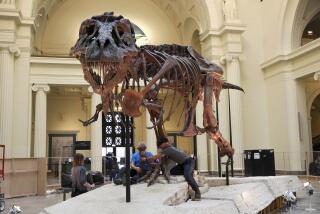Once Again, Dinosaurs Going, Going . . . Gone
- Share via
Bones, rocks, teeth and insects were once valued only by museums and scientists seeking clues to the world’s prehistory, but no more.
Thanks to a growing interest in the environment, outer space and the blockbuster movie “Jurassic Park” and its sequel, “The Lost World,” a market for natural-history collectibles has emerged among regular Homo sapiens.
Sotheby’s is planning a fall sale of the largest fossil ever found of Tyrannosaurus rex, the giant dinosaur whose notoriety in “Jurassic Park” made it a star.
The 45-foot fossil, which includes 90% of the creature’s bones, is expected to fetch more than $1 million.
On June 21, Phillips Fine Art Auctioneers in New York will hold its biannual auction of natural-history objects, an event in which the value of items sold has steadily surged since 1995.
“There’s an increased public awareness of the Earth’s history. The more people become aware of something, the more they want to be part of it,” said David Herskowitz, a consultant who helped Phillips launch the auction series.
“Owning a T-rex claw or skull is being part of it. People also buy for the beauty and the ‘cool’ factor,” he said.
For as little as $10 or $20, you can own “cool” jewelry such as pendants or brooches made from a dinosaur bone or a prehistoric insect preserved in amber.
For your mantelpiece or coffee table, a good stingray fossil starts at $1,200, said Eric Kendrew, who owns the Fossil Store, a mail-order catalog business in Florida. A diplomystus fish, a prehistoric herring, costs $1,000 to $4,000. A fossil of sycamore leaves, whose shape hasn’t changed for eons, is worth $150 to $200.
For deeper pockets, consider a 5-foot-long triceratops skull. It fetched $74,000 at Phillips in December.
A few years ago, Sotheby’s sold a few grains of moon rock brought back by Russian astronauts for $440,000 to a private American buyer. The pre-estimate was only $20,000 to $30,000.
The value depends on the quality and rarity, of course, and how complete a skeleton or other specimen is.
A complete dinosaur tooth that costs $5,000 to $15,000 would be worth only $500 to $5,000 if it were broken.
Many artifacts are bought by amateurs who are fascinated with natural history, rather than by museums or other institutions, which are facing funding problems.
“It’s fun to handle something 65 million years old from a great species no one has ever seen,” said Henry Galiano, owner of Maxilla & Mandible, New York’s oldest fossil store.
As a result, a Tyrannosaurus tooth that sold for $800 in 1995 was worth $2,000 a year later, he said.
But as with any other collectible, prices fluctuate.
A fossilized dinosaur egg that used to cost $3,000 is now worth only $800 to $900 because the demand caused a spurt in imports from China, Galiano said. But the Chinese government has now banned their export, helping to stabilize prices.
More to Read
Inside the business of entertainment
The Wide Shot brings you news, analysis and insights on everything from streaming wars to production — and what it all means for the future.
You may occasionally receive promotional content from the Los Angeles Times.










